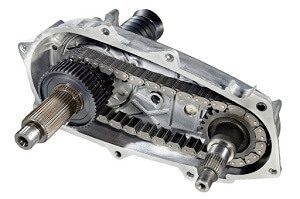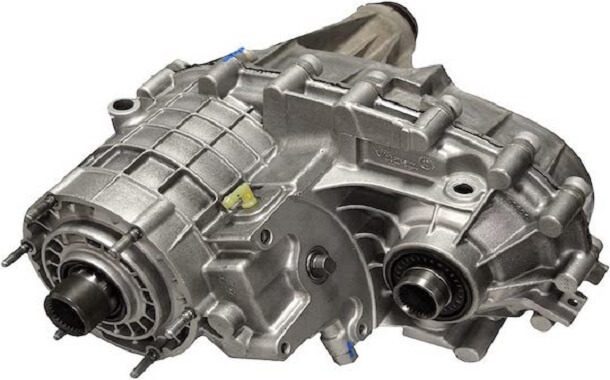Car Transfer Case Replacement Cost
The transfer case is a component of the transmission system found in 4×4 cars. The name even says what it does: it transfers power from the gearbox to both axles. That is, while a front-wheel-drive or rear-wheel-drive car has direct transmission, meaning the engine sends power to the gearbox, then directly to the wheels by the cardan and differential, to 4×4, 4WD or AWD cars, somehow the power must be transmitted to the other axle as well. That’s what the transfer box does.
If we force the transfer case or drive it without oil, it may fail. The most common cars to have a transfer case breakdown are the ones that have 4×4 traction locks. That is, if we engage the 4×4 traction from the lever or button at too high a speed, even though the manufacturer says it has to be done on the spot, we risk damaging the transfer case. The same goes if you drive without internal lubrication. But, in these cases, we can buy a second-hand one or recondition the old one, which is quite expensive and unpleasant, because, without the transfer case, the car cannot function.
How much does it cost to replace a car transfer case?
The transfer case replacement cost depends on some factors such as the make and model of the car, condition of the transfer case (new or used), and the place you are going to fix this problem – whether it is a local auto shop or a dealership. You should expect to pay anywhere between $2,350 and more than $2,950 for a car transfer case replacement, with an average cost of $2,550 to $2,800.
For instance, for a 1994 Toyota 4Runner, the cost of replacing the transfer case at a mechanic in California was only $1,550, but the transfer case was a used one.
On the other hand, the price of replacing the transfer case of a 2005 MW X3 is around $3,100.
You might also like our articles about the cost of a dune buggy, four-wheeler, or driveshaft balance.
The cost of the transfer case itself represents the main expense of the replacement. Depending on the make and model of the car, you will have to pay anywhere between $1,750 and $2,450 only for the parts.
When talking about the car transfer replacement costs we must consider also the labor costs that may be anywhere between $450 and $660 due to the time needed to perform this job. Repairing the transfer case requires the disassembly of many car parts, their cleaning, and reinstallation.
Transfer case details
A transfer case is another transmission that comes immediately after the gearbox. It can be a simple transfer box or have a reducer. In this transfer case, the 4×4 transmission is locked with a button, so that an SUV, such as a Hyundai Tucson, which travels all the time with front-wheel drive, can also operate 4×4 in off-road conditions. But the transfer case can be even more complex, computer-controlled, so that it automatically sends power to the front, rear, or both axles.
Another role of the transfer case is to equalize the rotation between the rear axle and the front axle. This is because the front wheels do not always roll at the same speed as the rear wheels, either due to turns or obstacles. Therefore, the transfer case also works like a differential, making the wheels roll the same regardless of the situation, without locking a specific wheel.
Symptoms of a defective transfer case may include:
– power transfer interruption: the driver feels some jerks between 12-30 miles/h, at moderate to strong acceleration; symptom specific to BMW models;
– loud noise when leaving the place by force – MB specific symptom;
– lack of traction to the front axle: in general, the computer detects this problem and turns on the fault indicators on board.
What are the extra costs?
Your transfer case is vital to the way your vehicle drives. If you suspect that there’s a problem, see an experienced mechanic as soon as possible so they can diagnose and fix any issues before irreparable damage occurs. Plan on spending anywhere between $90 and $125 for a simple diagnostic test. Though, according to Popular Mechanic, this type of diagnosis costs up to $410.
You can prevent damage to the transfer case by maintaining the right oil level in the transfer case assembly. Usually, the majority of mechanics charge anywhere between $80 and $165 for transfer case fluid replacement, depending on the geographical location and the make and model of the car. In the table below you will find the average prices for transfer case fluid replacement for some types of vehicles.
| Sample Vehicle | Price Range |
|---|---|
| Chevrolet Express 3500 | $120 – $140 |
| Volkswagen Jetta | $125 – $150 |
| Chevrolet Corvette | $130 – $150 |
| Infiniti M4 | $135 – $155 |
| Hyundai Veloster | $120 – $140 |
| Mini Cooper | $130 – $150 |
 The transfer case fluid should be changed every 30,000 miles or as it says in your car’s maintenance schedule.
The transfer case fluid should be changed every 30,000 miles or as it says in your car’s maintenance schedule.
In some cases, after the inspection and the diagnostic test other car issues may be discovered as well. For example, one of the most common problems is represented by the transfer case fluid leaks caused by a faulty seal. You should budget anywhere between $155 and $510 for the input seal replacement, depending on how much work will be needed. In case you will replace the input seal of your car’s transfer case you will have to pay anywhere between $25 and $55 only for the parts.
Another issue of the transfer case is represented by the pinholes inside of it, located in general on the top of the case. In this situation, you will have to replace only half of the transfer case and this will cost you anywhere between $455 and $680, depending on the amount of work. For the part itself, you will have to pay anywhere between $120 and $155.
Failure of the transfer case may be caused also by a damaged encoder motor and in some cases, the actual problem is just the ring found inside the motor. In this situation, you will have to pay only $35 to $65 for the replacement of the ring inside the encoder motor if you do it yourself. On the other hand, if you choose to have this repair done by a professional you will have to pay anywhere between $430 and $810 in labor expenses.
Important things to consider
When shopping for a new car transfer case or another piece of equipment for your vehicle you should have the next information in order to find the right parts much easier:
- the specifications of the engine (displacement capacity, cylinders, liters);
- information about the drivetrain;
- basic information about the car such as the make and model, mileage, year, and trim;
- details about the body style like a truck, sedan, convertible, 2-door coupe, or others;
- Vehicle Identification Number.
In case you buy the parts online, these must come with a warranty that covers any bad working equipment for a minimum of 90 days.
How can I save money?
You may be able to save money if you will replace the transfer case in the same place you went for the diagnostic test. Most of the mechanics will not charge for the diagnosis if you choose to fix your damaged transfer case with them.
Some people choose to replace the damaged transfer case with a used one and this way save money. You may be able to purchase a transfer case from a junkyard for only a few hundred dollars. However, this option is recommended only if the transfer case still has some kind of warranty.
A good idea would be to purchase a remanufactured transfer case that costs $1,000 to $2,450, depending on the make and model of the car.


Leave a Reply
Want to join the discussion?Feel free to contribute!